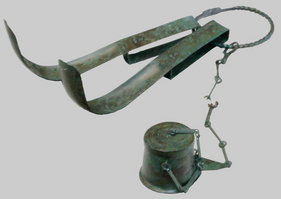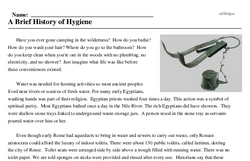A Brief History of Hygiene
Have you ever gone camping in the wilderness? How do you bathe? How do you wash your hair? Where do you go to the bathroom? How do you keep clean when you're out in the woods with no plumbing, no electricity, and no shower? Just imagine what life was like before these conveniences existed.
Water was needed for farming activities so most ancient peoples lived near rivers or sources of fresh water. For many early Egyptians, washing hands was part of their religion. Egyptian priests washed four times a day. This action was a symbol of spiritual purity. Most Egyptians bathed once a day in the Nile River. The rich Egyptians did have showers. They were shallow stone trays linked to underground waste-storage jars. A person stood in the stone tray as servants poured water over him or her.
Even though early Rome had aqueducts to bring in water and sewers to carry out waste, only Roman aristocrats could afford the luxury of indoor toilets. There were about 150 public toilets, called latrines, dotting the city of Rome. Toilet seats were arranged side by side above a trough filled with running water. There was no toilet paper. We are told sponges on sticks were provided and rinsed after every use. Historians say that these public latrines (with no privacy) were actually a place where people gathered to chat and make social connections. (So much for the embarrassment factor.)
Cleanliness during this time in history was rather painful and strange. Before soap became available, people were scraped clean with a tool called a strigil. A perfumed oil was applied to the skin and then scraped off with the strigil. A strigil was a small, curved metal tool used to scrape the dirt, sweat, and oil from the body. The wealthier people often had slaves do this task for them. Emperor Augustus of Rome was said to have a face full of sores due to excessive use of the strigil. YEOW!
A Roman poet named Juvenal wrote "The greatest blessing we can ask is a sane mind in a healthy body." The early Romans kept clean by taking regular baths. Once again, most Roman homes did not have a bathroom, so citizens went to a bathhouse. The bathhouse was a building with several rooms. Each room had its own pool with varying degrees of heat. Some of them were steam rooms; others were warm or cold-water pools. By law, women and men bathed separately. By the 3rd century A.D. there were almost a thousand bathhouses in Rome. There were eleven public bathhouses that could hold up to 1,600 bathers at one time. (Rather like our present-day water park, only without the swimsuits!)




